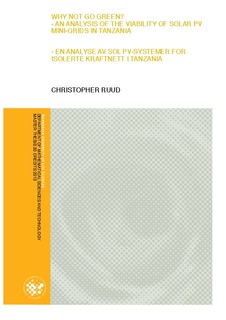| dc.description.abstract | Currently, practically all off-grid power systems supplying electricity access in rural Tanzania are diesel-based. The operator, Tanesco, spend more than US$ 45 million per year purchasing more than 50 million liters of diesel fuel, maintaining a diesel-based generating capacity of about 55 MW in total. The ambitious plans of increasing the level of rural electrification and limited ability to extend the existing power grid, introduces small off-grid power systems (mini-grids) as a viable option for electricity access in remote rural areas. Despite a certain level of hydropower and biomass resources being evident, the lion’s share of mini-grid candidates will call for other solutions, currently pointing toward diesel, PV or diesel-PV hybrid concepts.
The aim of this thesis has been to assess under which circumstances PV systems can be implemented for cost-competitive and viable power production on mini-grids in rural Tanzania. The capability of PV systems to provide certain levels of supply security in comparison to more conventional generating technologies depend on meteorological conditions, in addition to establishment of system design and operation criteria. Domestic solar insolation ranges from less than 3.5 kWh/m2day and high seasonal variation in the Kilimanjaro area of the North Eastern Highlands zone, to about 6.0 kWh/m2day and very low seasonal variation in Central Tanzania. Standard deviations in the average annual insolation data has been estimated to less than ±5 % for all conducted measurements, suggesting a high potential for relatively predictable PV power production in most zones.
An LCOE of 0.61 US$/kWh estimated for a base-case PV system under average irradiation conditions is within the willingness to pay for low-consumption electricity (estimated to range from 0.8 US$/kWh to 1.2 US$/kWh). The results also suggest that PV systems are significantly less costly than diesel-based generation, and competitive to diesel-PV hybrids. The technical modularity of PV systems may enable developers to implement stepwise capacity expansion, in order to reduce initial expenditure and provide gradual development of electricity access to rural communities.
While it makes good economic sense to pursue solar energy on mini-grids, there are several meaningful and challenging barriers. The high initial costs of PV systems, combined with income uncertainty in rural areas due to low customer affordability introduce high financial risk, which makes it somewhat difficult to attract private investors. In addition, LCOE estimates obtained for PV systems involve a high degree of configuration dependence and sensitivity to availability of the solar resource and operational criteria. In particular, the supply security required from a PV system will determine the extent of battery storage capacity needed, which typically represents about 30 % of overall initial costs.
Up-front donor support to developers presenting economically viable operational models and business plans for off-grid electrification projects, may contribute to overcome capital boundaries and promote a broader utilization of solar and other renewable resources on mini-grids in Tanzania. | no_NO |
